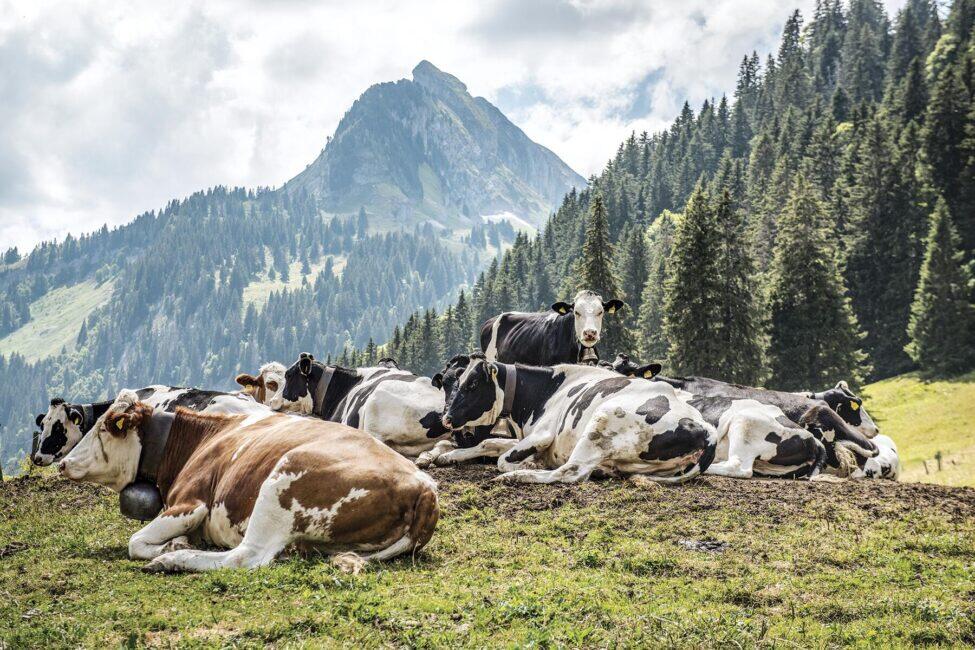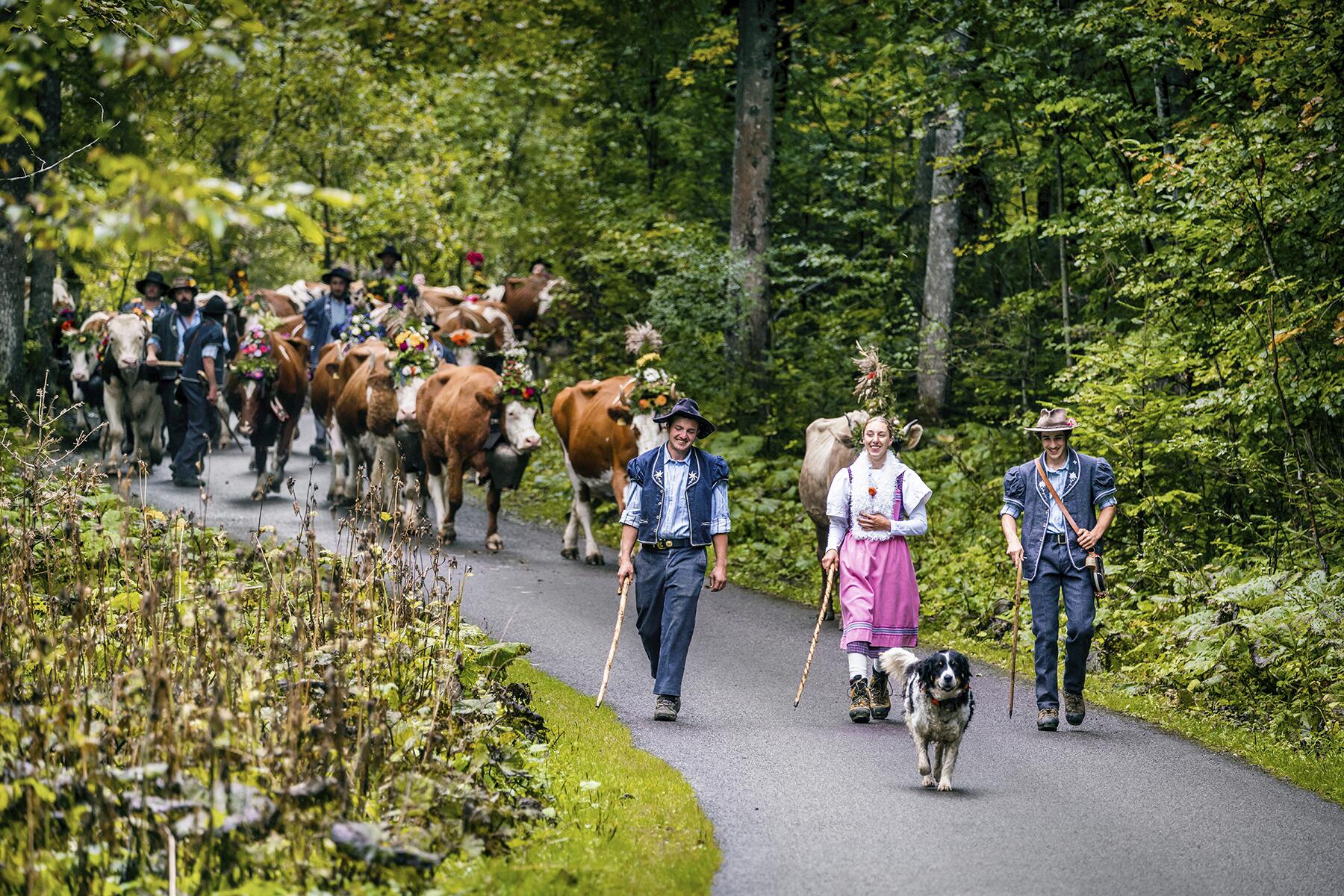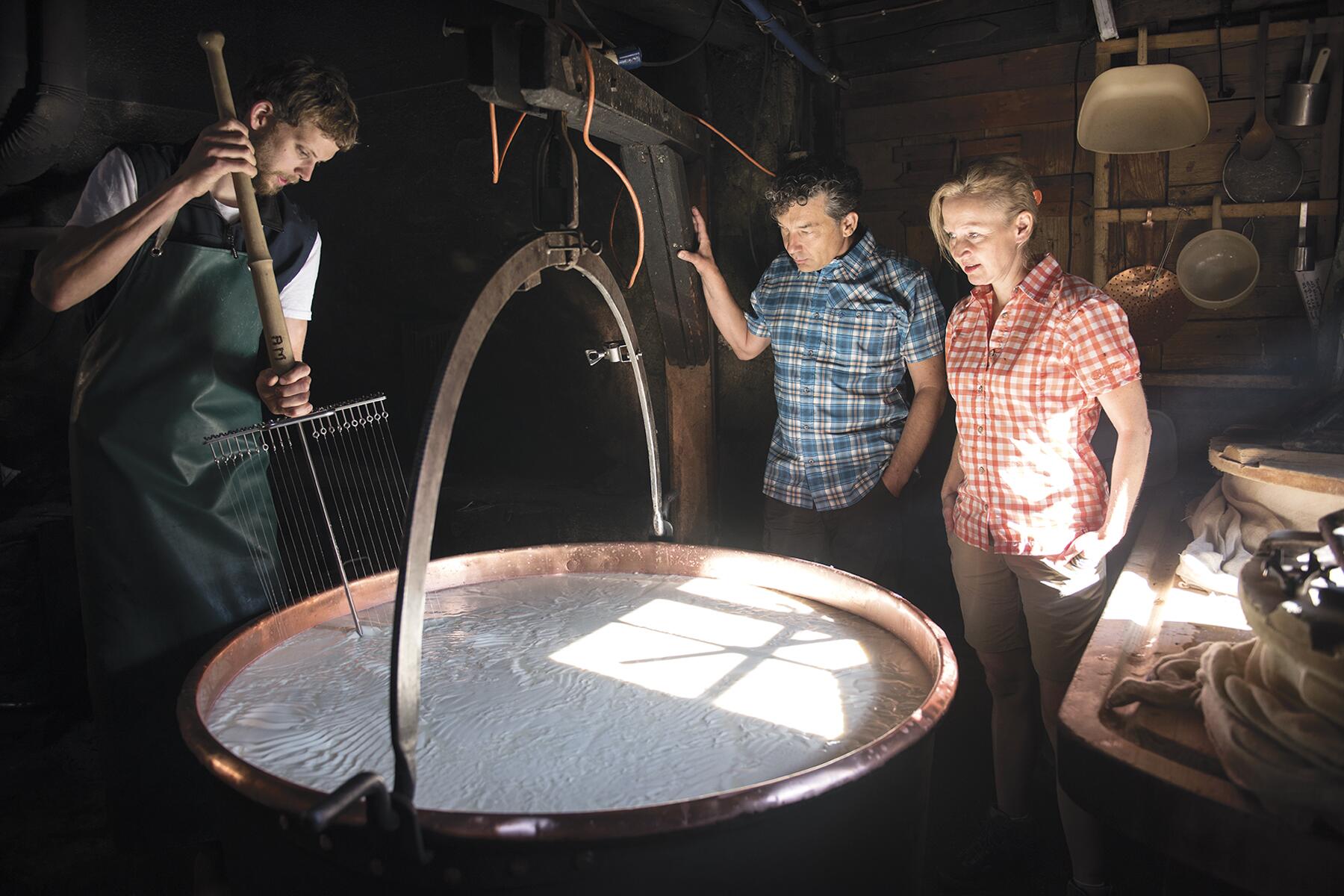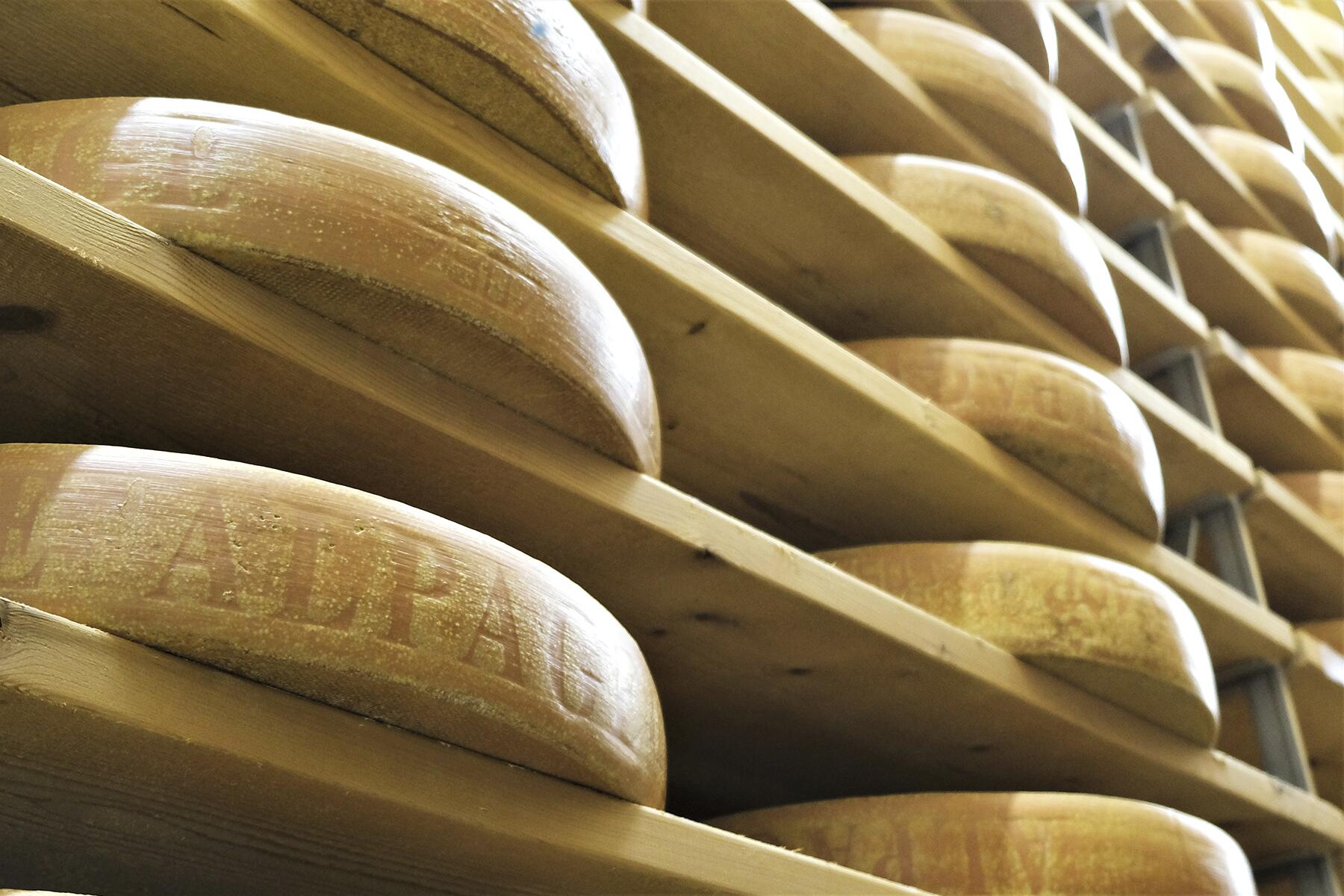If you love cows and you love cheese, you have to visit this part of Europe ASAP.
What comes to mind when you think of Switzerland? Glitzy ski resorts, trains winding through mountains, and luxury watches are all excellent contenders, but if one ingredient represents Switzerland, it has to be cheese.
Gruyere. Emmental. Sbrinz. There are more than 450 varieties of cheese in Switzerland, so suffice it to say that cheese is life, and the rest (including chocolate) is mere detail.
If you have traveled to Switzerland, you would have noticed that cheese is a nationally loved ingredient among the Swiss. You can find exceptional cheese sold in supermarkets at an affordable price, and cheese shops (fromageries) are dotted around quaint little villages and towns for passer-byers to duck into when cravings strike. You will even find vending machines in the middle of nowhere offering cheese at the push of a button for hikers and village folk to enjoy on Sundays when commercial outlets are inevitably closed.
While the rest of the world battles with new food trends that restrict dairy intake, Switzerland remains steadfast in maintaining century-long cheesemaking traditions and preserving what could be the country’s most respected activity: cheese production.
Yet, while an average Swiss consumes more than 21 kilos of cheese a year, “real” Swiss cheese (some refer to it as indigenous cheese) is teetering on extinction. The belief is that with new diet trends, new regulations in government laws that restrict raw milk being used in cheese production, and century-old activities like desalpe not passed down from one generation to another, authentic cheese, particularly from the alpine regions, may be lost forever.
Recommended Fodor’s Video
Dating back to 1115, inasalpe and desalpe, the activity of moving cows up and down the Alps at the beginning of the summer and end, respectively, is something that the Swiss desperately want to carry on in an effort to maintain the same level of expertise and high-quality cheese the country is deservingly known for.
The Annual Descent
In the United States, fall is a glorious time when pumpkin patches and apple-picking farms are prime destinations for travelers to bask in the autumnal weather. In Switzerland, the same festive spirit is seen in the countryside with desalpe being the most loved mountain tradition for kids of all ages to enjoy, where the cows finally descend from high alpine pastures (after spending the summer in the mountains) and return home for the winter season.

“It’s very gratifying to have complete traceability, to know the person who grew or raised the product, and then to accompany and magnify that product all the way to the end consumer!”
While there are many important steps in the cheese-making process, desalpe, is probably the most unique. At high altitudes, cows feast on alpine flowers, herbs, and untainted grass, producing exquisite cheese with aromatics you would never get from cows fed winter silage. If you remember your high school science classes, you will know that you are what you eat and with the cows, the same rings true: the more varied and herbaceous their diet is, the richer the milk and cheese production. Alpine cheese is much loved and appreciated by the Swiss with it being more nutritious, richer in omega-3 and from a taste perspective, the cheese is unlike any other commercial product: floral notes and yes that farmy taste instantly transport you to high alpine pastures from the first bite.
Prominent Swiss chefs like Stephane Decotterd and Federic Ziörjen of Le Vieux Chalet work closely with local farmers so that they can support the age-old farming tradition and serve harder-to-find alpine cheese in their gourmet restaurants.
On a recent lunch in the UNESCO Lavaux vineyards on the grounds of Maison Testuz, chef Decotterd explained why serving regional food matters to him.
“It’s a necessity for me to be able to express myself in the kitchen, and I thrive on exchanges with producers. It’s very gratifying to have complete traceability, to know the person who grew or raised the product, and then to accompany and magnify that product all the way to the end consumer! What’s more, local sourcing means that many of the small producers around our restaurant are able to make a living, preserving local know-how. Last but not least, it allows us to produce food that tastes of the place we’re in while reducing our carbon footprint,” says the Michelin-starred chef who hails from Bulle, a region in Gruyere where the largest desalpe festival happens each year.
Similarly, Chef Ziorjen, shares that while his property, Le Vieux Chalet is “small in size,” what he and his team do are done so with a lot of heart and passion which is reflected in the way he works directly with farmers for both cheese and meat.
The Tradition Continues
The challenges associated with making alpine cheese are many. Not only are younger generations no longer interested in working like their grandparents did with technology driving faster and more efficient cheesemaking production, but it can also be dangerous. Cows can be reportedly clumsy in their ascent and descent and easily tumble down the mountain and bring their herd and farmers down with them. On average, the cows climb 7000 feet and cover about 11 miles; imagine herding 500kg-heavy cows up mountains that stand ten times as high as the Empire State Building–quite a feat!

Mike Gluser, co-founder of Jumi Cheese located in Vechigen, Bern says that desalpe is a fading tradition in some regions now but still a living tradition the Swiss are very proud of. “When I was a child, I would go with my family, but my brother did the annual activity without fail; he would spend the whole summer there,” says Mike.
Although fun to watch for onlookers, the process of desalpe is not as easy as it looks. Mike admits that, like all highly prized items, a lot of labor goes into herding cows up high-alpine pastures.
“You will get many arguments for not doing so, from government regulations of food safety, security issues, finding people to tolerate the tough work for a small salary, and also some forget that more and more now fewer cows can actually tolerate the Alps. You can not go with a super-intensive cow up to the alp, she will not give you milk in the alps.”
“When I see the cows eating the fresh fine grass during the summer, the farmers tending to their hay, the cheesemakers working on Sunday morning milking the cows before moving to the farmers market to sell it, it motivates me to continue our traditions.”
Despite the dangers associated with herding cows up more than 7000 feet above sea-level, many farmers follow traditions set by their ancestors who wholeheartedly take on this annual challenge to keep this living custom alive. The main areas where travelers can witness desalpe are in the mountainous regions known for cheese production, like Charmey and Gstaad on the French-speaking side of Switzerland, and should not be missed if you enjoy cheese and mingling with the locals when on vacation. The events run throughout the fall and depend on when farmers want to bring their cattle down.
“I was born in Bulle in the Gruyère region, so it’s something very important. I had an uncle who went to the mountain pastures every spring with his herd. Throughout the summer, he lived in his mountain chalet, looking after his animals and making his cheese. As children, we always spent a few days with him at the chalet during the summer vacations. And at the end of the summer, the return to the plane was always a party! Even today, the ‘inalpes’ and ‘désalpes’ are important moments in mountain farming. It’s not just folklore,” says Chef Decotterd.
But you don’t have time to visit a desalpe festival during your vacation in Switzerland, one way to support farmers is to enjoy alpine cheese served in a reputable restaurant. In Gruyere, a region in Fribourg known for its famous cheese of the same name, restaurants Le Tonnelier and Le Vieux Chalet also serve alpine cheese, with the latter working with local producers Fromagerie de Marsens and Fromagerie de Charmey.
The bonus of eating lunch or a gastronomic dinner in restaurants such as Le Vieux Chalet is that you also get a history lesson from friendly staff (shout out to Johnathan). Other places in Gruyere worthy of a pitstop include a visit to a Buvette, essentially a hiker’s hut. On the same part of the valley, Chez Boudji is my favorite for fondue, raclette, and rosti where owners Alexandra and Yves Jaquet serve up award-winning Swiss cheese by William Wyssmuller (which you can enjoy in NYC at The Lavaux Winebar).
Despite all the hurdles, the Swiss government is trying to maintain the tradition. Last year, it listed alpine culture as a UNESCO Intangible Culture, fearing it will be forgotten and lost forever. The government also encourages farmers to take their cattle up the mountain by rewarding them with a subsidy of around CHF400 ($412) per cow each summer.
If government incentive and passing on culture is not motivation enough, Mike says it is the tradition of carrying on something so ingrained in Swiss culture that encourages him to push on. “When I see the cows eating the fresh fine grass during the summer, the farmers tending to their hay, the cheesemakers working on Sunday morning milking the cows before moving to the farmers market to sell it, it motivates me to continue our traditions,” says Mike. Tres bien, let’s all eat more cheese!

Where to Experience Alpine Culture and Stay During the Festive Season
Le Vieux Chalet, located in Cresuz, in the heart of Switzerland’s cheese-producing region Gruyere has the cows pass by the historical property during the desalpe festival. Considered one of the biggest festivals of the year, more than 10,000 visitors gather during the event each year with farmers parading into the town of Charmey with their cattle fully adorned with flowers and bells to celebrate their summer in the alps.
Le Tonnelier in Bulle is where history melds with tradition with the newly renovated boutique hotel being a top spot for travelers who want to enjoy visits to the Gruyere castle by day and by night, experience an exciting and under-the-radar chef, Carlos Tenera for his brasserie-style dishes prepared in an elegant way. Be sure to save room for dessert, they are Michelin-worthy and the local cheese plate is a winner, too.
Guarda Golf Hotel and Residence: Located in Crans-Montana, celebrities and golf enthusiasts frequent the hotel, but gourmets choose it as the perfect spot for eating as well. Despite the hotel restaurant serving up Middle Eastern cuisine, alpine cheese, and yes, fondue can be experienced in the luxury hotel, making for a great winter spot. The Sunday Brunch is a good choice on weekends for the taste of both worlds in one seating.
Romantik Hotel Hornberg might be a destination for wellness, but it is also a great place for foodies. From breakfast to lunch and of course after a stunning dinner with panoramas of Saarnen, guests can enjoy a range of local cheese produced a few miles within the property.
Lausanne Palace was one of the last palaces built in Switzerland and despite its luxury and historical charm in the Olympic city of Lausanne, eating in one of the three restaurants is a delight. No cows will parade through the streets of the city but you will be able to eat aged alpine cheese at the gourmet restaurant, La Table and that’s where you will find Gruyere Caramel AOP–aged for a minimum of 38 months.
Hotels de Horlogers in Vaud is nestled in the mountainous regions of the French-speaking region of Switzerland. Although luxury watch fans frequent the hotel, the hotel is a destination for people looking to get back to nature with nearby mountains to hike, ride and walk. The hotel restaurant, Brasserie des Horlogers has seasonal alpine cheeses available.






